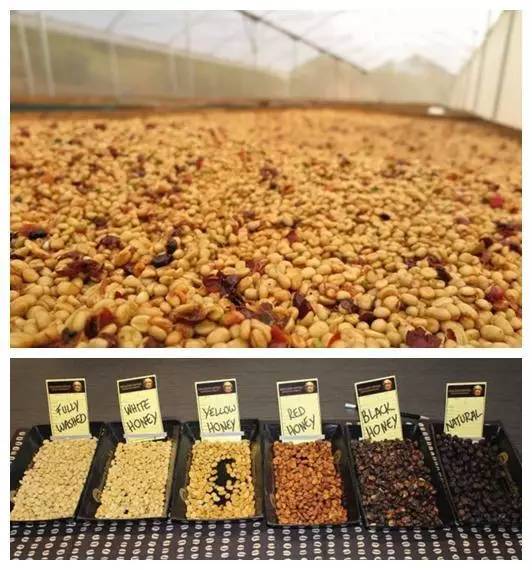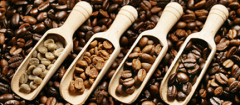Why is Costa Rican Coffee Honey Treated Popular?

For professional baristas, please follow the coffee workshop (Wechat official account cafe_style)
Honey treatment, called HoneyProcess or MielProcess, is the method of peeling off the pulp and drying the fruit with endocarp. Coffee gardens in Costa Rica (CostaRica), Panama (Panama) and Guatemala (Guatemala) all use this method.
Honey treatment began in Costa Rica and was tried by local coffee farmers to improve the quality of coffee beans, and then slowly spread to other countries. So why do Costa Rican farmers try this method of processing? Since farmers' income mainly depends on the trading of coffee beans, the better quality coffee beans can bring higher profits, so it is not surprising that farmers keep trying new processing methods.
For a coffee producer, there are three ways to improve the quality of coffee beans: first, to improve the processing method; second, to change the planted tree species; and third, to improve the soil quality of the farm, that is, to migrate the farm. But just like when we extract coffee, we will first adjust the extraction amount, pressure and temperature before changing the amount of coffee powder and grinding degree, we will first choose to change the conditions that can save time and cost as much as possible. It is time-consuming and laborious for farmers to change tree species and migrate farms, so improving processing methods has become their first choice.
The conditions of honey treatment require:
Honey treatment is a complex, time-consuming and difficult processing method.
The first step is to select high-quality fruit, and then peel off the pulp to leave the endocarp, where the endocarp is the core of honey treatment. The endocarp is rich in sugar and sour taste, which will slowly seep into the coffee beans during the drying process.
The second step is drying, which is the most important condition for the production of high-quality coffee beans. The time of drying is very important, if the time is short, the sweet taste is not good; over time, the coffee will be moldy, you need to pay special attention.
The picture is from cupping spoon
What is the difference between "yellow honey", "red honey" and "black honey"?
According to the thickness of pectin planing, the length of sunshine time (or drying thickness), and the frequency of turning when drying, honey treatment can be divided into black honey, red honey, orange honey, yellow honey and white honey.
According to the thickness of pectin, it can be divided into black honey, red honey and yellow honey:
Black honey: hardly removes pectin, so it takes the longest time to dry and lasts for more than 14 days. In order to avoid drying too fast, cover will be used to block too strong sunlight to make sugar conversion more fully.
Red honey: remove 25% pectin (the specific methods of each manor vary), the sun lasts for about 12 days, and shading sheds may also be used in the process.
Yellow honey: remove 40% pectin and receive maximum light drying for about 8 days
It is also divided into black honey, red honey and yellow honey according to the turning frequency when drying.
For example, La Lajas Manor in Costa Rica, 100% retains pectin, [yellow honey]: coffee is placed on the scaffolding and flipped once an hour; [red honey]: coffee is flipped several times a day, not as frequently as yellow honey; [black honey]: once a day.
For example, Honor Manor in El Salvador, yellow honey and white honey both retain 20-30% pectin. According to the different drying thickness and turning times, [yellow honey]: thick layer drying, less turning times, long drying time; [white honey]: thin layer drying, more turning times, short drying time.
[orange honey treatment] orange honey
This is derived from the traditional method of honey treatment.
Fully ripe fruit is picked, selected and removed, which is the same as washing, but the special feature is that a certain amount of pulp juice is left when the pulp is removed, and then dried in the sun bed, and the pulp is left on the "parchment". Leaving a certain amount of juice creates a brighter flavor for the coffee.
A brief summary:
Sweetness: black honey > red honey > yellow honey > white honey
Cleanliness: White honey > yellow honey > red honey > black honey
Sense of balance: red honey / yellow honey > black honey / white honey
Important Notice :
前街咖啡 FrontStreet Coffee has moved to new addredd:
FrontStreet Coffee Address: 315,Donghua East Road,GuangZhou
Tel:020 38364473
- Prev

Which tastes better, Jamaica Blue Mountain Coffee or Panamanian Rosa?
Professional barista communication Please follow the coffee workshop (Wechat official account cafe_style) people are always looking for the best things, looking for the best wine, the most charming cigars or the noblest champagne, etc., and coffee is the same, it is happy to drink good coffee, so people also start to pursue better coffee, from the old Jamaica Blue Mountains or
- Next

Costa Rican double fermented raisin treatment, Costa Rican coffee worth a try
Professional barista exchanges please pay attention to the coffee workshop (Wechat official account cafe_style) [double fermented honey treatment] treatment: [100%] sticky layer retention and anhydrous treatment, on the day of harvest, peeling and retaining sticky, and then drying, the unique variety of Huangkaduai black honey treatment in the manor is named raisin treatment, the overall taste is rich and changed.
Related
- Detailed explanation of Jadeite planting Land in Panamanian Jadeite Manor introduction to the grading system of Jadeite competitive bidding, Red bid, Green bid and Rose Summer
- Story of Coffee planting in Brenka region of Costa Rica Stonehenge Manor anaerobic heavy honey treatment of flavor mouth
- What's on the barrel of Blue Mountain Coffee beans?
- Can American coffee also pull flowers? How to use hot American style to pull out a good-looking pattern?
- Can you make a cold extract with coffee beans? What is the right proportion for cold-extracted coffee formula?
- Indonesian PWN Gold Mandrine Coffee Origin Features Flavor How to Chong? Mandolin coffee is American.
- A brief introduction to the flavor characteristics of Brazilian yellow bourbon coffee beans
- What is the effect of different water quality on the flavor of cold-extracted coffee? What kind of water is best for brewing coffee?
- Why do you think of Rose Summer whenever you mention Panamanian coffee?
- Introduction to the characteristics of authentic blue mountain coffee bean producing areas? What is the CIB Coffee Authority in Jamaica?

